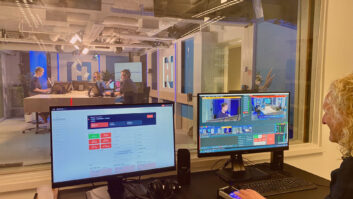Broadcasters Should Be Cooking Up Services Now To Appeal to the Tastes of Future Users
Part of my duties involves work with a standards body called the TV-Anytime Forum, which is developing specifications for interoperable Personal Video Recorders (PVRs, such as TiVo, Replay, UltimateTV, DishPlayer, etc.). The group meets around the world. One of the more fascinating meetings was hosted recently by Novell at its headquarters in Provo, Utah.
At the meeting’s end, a large group of delegates headed off to dinner at a nice restaurant. As the meal progressed and the venue became less busy, the restaurant’s pleasant hostess came over to our table and asked, “So what exactly is ‘TV-Anytime’?” The group nominated me to describe its work, and not knowing anything about her, but assuming no special knowledge of digital media technology, I started slow and waited for cues of recognition.
From her reactions, I gathered that she was starting to get it, but I soon saw signs of TMI (too much information) setting in. (I get that a lot, especially from my kids, where it happens within nanoseconds after I start talking.)
Just then, some new customers arrived and the hostess had to attend to her work, leaving me with a sense that she felt sorry she had asked.
An enjoyable dinner continued, but our table was surprised a few minutes later to get a visit from the executive chef of the restaurant. After inquiring briefly about our satisfaction with the meal, he turned his line of questioning to the PVR. It turns out that the hostess had, in fact, captured the essence of the Forum’s work and faithfully represented it to the chef back in the kitchen. Although she had no experience with a PVR herself, the chef was a multiple-TiVo owner and rabid enthusiast of the technology, so he hustled out to our table, armed with lots of questions.
After several minutes of deep PVR discussion, the chef advised the group, “Now you have to do the same thing for radio.”
Tomorrow’s special
At this point, I was the only person at the table who was interested in continuing the conversation; most of the others were exclusively TV-oriented. So I probed the chef’s thinking independently.
He acknowledged that he was also a multi-vehicle XM Satellite Radio user, and strongly desired some sort of electronic program guide or EPG and integrated digital storage in a radio receiver, including local terrestrial services.
Unfortunately, I had no good news for him regarding progress in this direction, but it speaks to an important open issue: What is the future for personalization or interactivity in the next generation of radio?
This is a fundamental new requirement to any media system in the post-Internet age. Users will no longer be satisfied (at least for some parts of their listening time) with random browsing of the available services in real time. If a medium does not offer some method of seeking desired content and capturing or time-shifting it, terrestrial broadcast radio could become marginalized.
The model of today’s purely passive listening will never fully go away, but it will become increasingly less valuable as other more personalized services emerge.
Some will argue that radio isn’t used this way, and that as long as you know the format of a particular service or channel, you have all the information you need. Today’s terrestrial radio doesn’t even have that – although RBDS was supposed to provide a text display of this data for FM stations, and various database ROM systems have come and gone – so a channel surfer still has to scan and listen to find a particular format. If a commercial is running as the listener tunes by, the format’s existence on the dial is not recognized.
IBOC radios w likely ill provide a format display, but this too remains a promise yet to be fulfilled. Satellite radio is today’s only consistent provider of visual format identifiers, and they are essential in navigating these multichannel services.
Yet there are plenty of occasions where format identification, or even title/artist data, isn’t enough.
Consider the case where you’re at home watching a sporting or news event on TV, and then have to leave the house, but you’d like to keep listening to the event on the radio. How do you find out if it’s being broadcast and what station it’s on?
At least TV viewers without EPGs can consult TV Guide or the newspaper for comprehensive and consistent program listings. Radio listeners typically are on their own in such cases.
Or what if you’re a fan of a national weekly show like “American Top 40,” “The Grand Old Opry,” “The Metropolitan Opera” or “Prairie Home Companion,” and you’re traveling, but would still like to hear it in the city you’re visiting? How to find the time and station?
And what about commercial opportunities for these new data services (subscriptions, banner ads, etc.), such as digital TV broadcasters are now contemplating and starting to deploy?
These are the services that broadcasters should be developing for their future broadcasts. Higher audio fidelity is fine, but added convenience and responsiveness to personal needs provided by EPGs, integrated storage/timeshifting and synchronous enhancement data do more to build listener loyalty and good will.
The digital transition that seems ready to begin is the best – and perhaps the only – opportunity that radio broadcasters have to enable such features. Given the surfeit of competitive services likely to emerge, broadcasters should be doing everything they can along these lines to retain current audiences and appeal to the listeners of tomorrow. Anything less is a recipe for failure.










